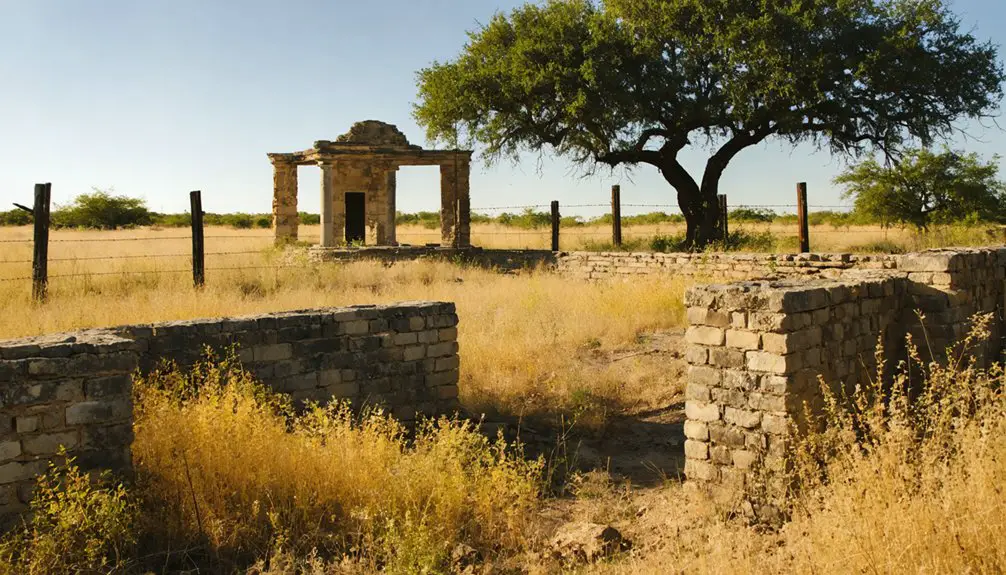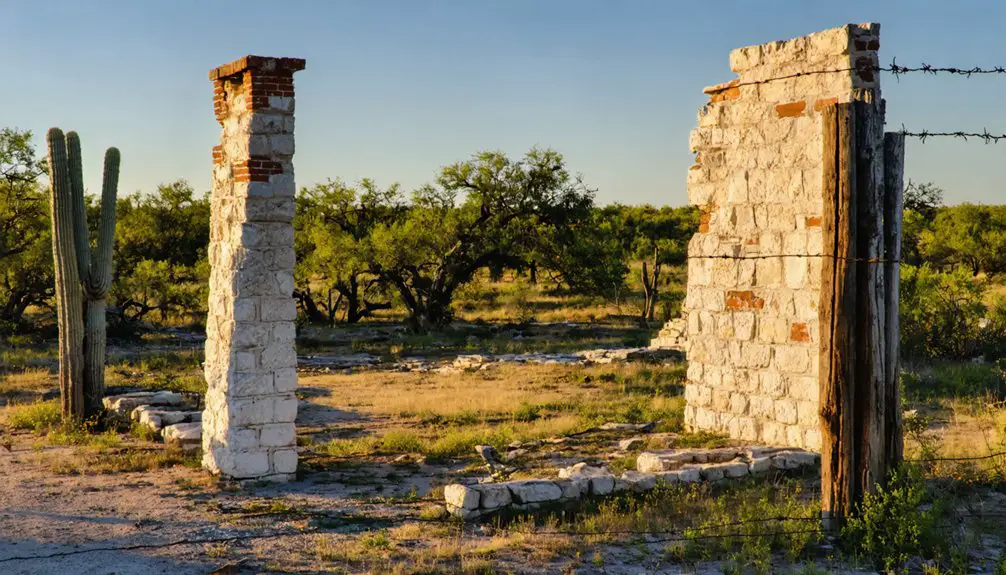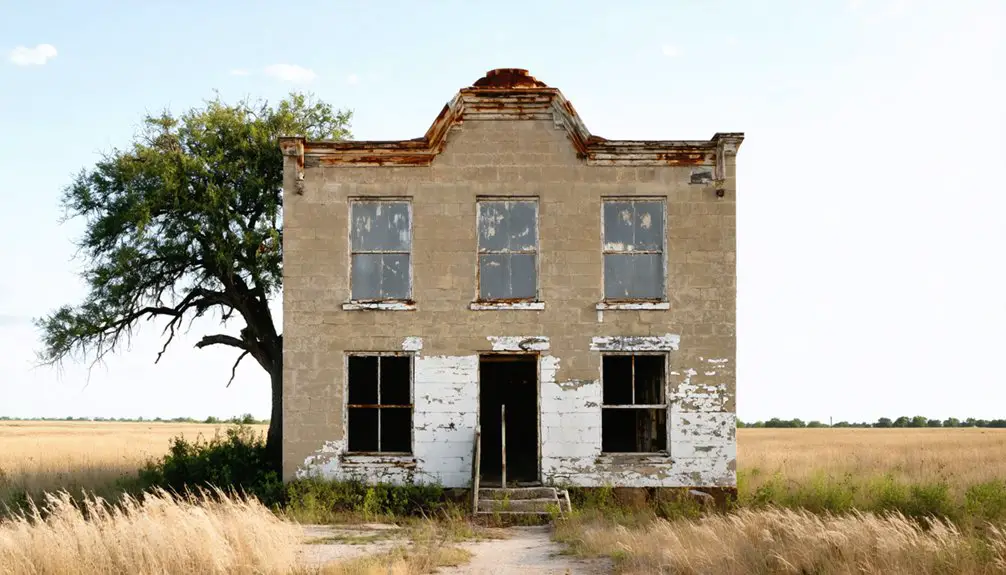You’ll find Cora’s historic log courthouse nestled in modern-day Comanche County, Texas, where this ghost town once thrived as the county’s first seat in 1856. Originally established as Troy in 1854, the settlement was renamed to honor Miss Cora Beeman before becoming a crucial frontier refuge during Indian raids. While the town’s prominence was short-lived, its preserved courthouse stands as a testament to pioneer-era Texas, offering countless stories of early frontier life.
Key Takeaways
- Cora, Texas was established in 1854 and served as Comanche County’s first county seat before becoming a ghost town.
- The settlement featured a historic log cabin courthouse, now preserved in Bicentennial Park as a testament to pioneer architecture.
- Named after Cora Beeman from Bell County, the town thrived briefly with 126 farms established by 1870.
- The community declined rapidly after losing its county seat status in 1859, eventually leading to abandonment.
- Today, only Texas Historical Markers and the preserved courthouse remain to mark Cora’s historical significance.
Birth of a Frontier Settlement (1854)
As Texas pushed its frontier boundaries westward in the 1850s, the settlement of Troy emerged in 1854 within what would soon become Comanche County.
Texas’s westward expansion in the 1850s brought forth Troy, an early settlement marking new frontiers in future Comanche County territory.
You’ll find its origins tied to the broader expansion of Texas settlements, as pioneers ventured into lands previously held by Comanche tribes.
The frontier culture of this new community quickly took shape when the town was renamed Cora, honoring Miss Cora Beeman from Bell County.
The settlement patterns followed the natural contours of the Edwards Plateau, where fertile soil attracted determined farmers and ranchers.
You’ll recognize the strategic timing of Cora’s establishment, as it coincided with significant land grant expansions from earlier Mexican concessions to Stephen F. Austin and Samuel May Williams.
The community’s development reached a milestone in 1856 when residents constructed the one-room log cabin that would serve as the county courthouse.
The town’s role as county seat solidified its importance until 1859, when the title shifted to the newly established town of Comanche.
The Log Courthouse Legacy
If you’re tracing early Texas frontier construction methods, you’ll find the Cora Log Courthouse exemplifies the era’s squared-log building techniques in its compact 12’7″ by 12’10” frame.
Originally serving as a log cabin residence, the structure became the first local courthouse when established in 1856. Through multiple relocations and an 1880s adaptation into a private residence, this sturdy structure has endured as a symbol of frontier ingenuity. The building served as the first county seat for Comanche County before government operations moved to the town of Comanche in 1859.
Today, you can examine this preserved piece of Texas judicial history at its current home in Bicentennial Park on the Comanche County Courthouse grounds, where it continues to educate visitors about early government infrastructure.
Historic Construction Methods
When frontier settlers established Cora’s first courthouse in the mid-1800s, they followed the practical building traditions of early Texas, constructing a modest 12’7″ x 12’10” squared log structure.
Their log craftsmanship reflected both necessity and ingenuity, creating a durable civic building from locally-sourced materials. The structure’s significance is highlighted by its doorway entrance surviving into modern times, as documented in 2005.
You’ll find these key construction methods were vital to the courthouse’s structural durability:
- Split logs were squared by hand using axes and adzes to guarantee tight-fitting joints.
- Horizontal log stacking with notched corners created a stable, interlocking framework.
- Clay or mud chinking between logs provided weather protection and insulation.
- Simple timber framing supported a basic shingled roof.
This practical approach to construction proved so effective that the building survived multiple relocations and later integration into a residence around 1880.
Present-Day Preservation Site
Today, the Old Cora Log Courthouse stands as a tribute to Texas frontier heritage, carefully preserved under the stewardship of Comanche County and the Texas Historical Commission.
You’ll find this architectural significance embodied in its squared log construction, which exemplifies mid-19th century Texas courthouse design. Originally constructed as a one-room log building, the courthouse represents a quintessential example of pioneer-era architecture. The site’s ongoing restoration focuses on stabilizing and repairing the structure, particularly addressing deterioration on the north elevation.
Community engagement thrives through educational tours, local heritage events, and a replica courthouse in Comanche’s town square. The structure was moved to a bluff overlooking the South Leon River after Cora’s decline.
You can explore the site’s rich history through interpretive signage and historic markers, while state preservation grants and local fundraising promote its continued care.
The courthouse serves as both a representation of frontier governance and a crucial educational resource for understanding Texas pioneer life.
Life in Early Comanche County
You’ll find that life in early Comanche County balanced frontier justice with pioneer family settlements, as evidenced by the formation of home-guard companies and the community’s stance against outlaws like those associated with John Wesley Hardin in 1874.
The Comanche-Apache conflict that had dominated the region prior to settlement gradually shifted as pioneer families who settled along Mercer and Resley’s Creeks in 1854 faced daily survival challenges, including the constant threat of Indian raids that intensified between 1860-1875. When raids occurred, settlers often sought refuge at places like the Mustang Water Hole, which became a crucial defensive position during conflicts with Native Americans.
Your understanding of early county life wouldn’t be complete without recognizing how the Double Pens fort served as both a defensive shelter and a community gathering place, demonstrating the settlers’ resourcefulness in combining safety with social needs.
Frontier Justice and Law
As settlers pushed into the Texas frontier in the early 1800s, the Texas Rangers emerged as the primary force of law and order in areas like Comanche County.
You’d find these citizen volunteers patrolling the dangerous frontier, protecting isolated settlements from raids while enforcing frontier law in a region where formal courts were scarce.
The Rangers’ presence in Comanche County brought both security and controversy:
- They’d carry Colt revolvers and use relay firing tactics to counter Native American raids.
- You’d see them mediating disputes over land, cattle, and resources between settlers.
- They’d blur the lines between official enforcement and vigilante justice.
- You’d witness their transformation from volunteer militia to professional lawmen as the county grew.
Under leaders like John Jack Coffee Hays, Rangers were granted extensive authority to track and execute thieves without the need for trials.
Pioneer Family Settlements
Life on the Texas frontier transformed dramatically when the first pioneer families arrived at Mercer Creek in 1854. You’d find the Mercers, Colliers, Holmsleys, and Tuggles pitching tents along the creek, with Capt. Frank Collier constructing the area’s first log house.
Pioneer family dynamics centered around survival and community resilience. They’d gather at Double Pens, a fortified stockade where multiple log cabins provided refuge during Indian raids.
Inside these protective walls, you’d witness the foundation of their social structure – the Indian Creek Methodist Church held services there, and R.W. Welborne taught the settlement’s first classes.
Despite constant threats to their livestock and crops, these determined families established 126 farms by 1870, transforming the wild frontier into a thriving agricultural community.
Daily Survival Challenges
Despite the promise of opportunity in early Comanche County, settlers faced relentless daily challenges that tested their resolve. You’d have found yourself constantly adapting to survive in this unforgiving frontier, where self-sufficiency wasn’t just a virtue – it was essential for staying alive.
- You’d need to master water conservation techniques, digging wells and carefully rationing every precious drop in the semi-arid climate.
- You’d spend countless hours on food preservation, storing and protecting supplies from harsh weather and raiders.
- You’d learn to defend against Comanche raids while managing your daily farming and ranching duties.
- You’d have to develop strong trading relationships within your community, bartering for essential goods when supply caravans couldn’t reach your settlement.
These hardships shaped the rugged character of early Texas pioneers, proving their determination to carve out a life of freedom on the frontier.
From County Seat to Abandonment

When Cora became Comanche County’s first county seat in 1856, few could have predicted its swift decline.
You’ll find that this Texas settlement, originally named Troy, operated from a simple log cabin courthouse that served the county’s early administrative needs.
But Cora’s prominence proved short-lived.
Geographic Features and Town Layout
As you explore the remains of Cora today, you’ll notice its strategic placement among the gently rolling hills of east Texas, where the town once sat at an elevation between 400 and 600 feet above sea level.
The topographic influence shaped Cora’s development, with its grid-pattern layout typical of 19th-century Texas settlements. Water accessibility through wells and nearby creeks sustained the community during its brief existence.
Key features of Cora’s layout included:
- A central business district surrounded by residential plots
- Mixed hardwood and pine forests that provided essential building materials
- Loamy soil that supported agriculture and ranching activities
- Open spaces for community gatherings and markets
The town’s natural setting offered both advantages and challenges, ultimately playing a role in its eventual abandonment.
Historical Markers and Preservation

While Cora’s buildings have largely vanished, the town’s legacy endures through its Texas Historical Markers, particularly the one commemorating the Old Cora Courthouse near SH 16 in Comanche County.
You’ll find the marker significance extends beyond mere commemoration – it tells the story of Cora’s brief prominence as the county’s first seat of government.
The original courthouse, a modest 12’7″ by 12’10” log structure, survives today despite significant preservation challenges. It’s been moved multiple times since its 1880 incorporation into a residential house, reflecting the adaptability needed to protect Texas frontier history.
The Texas Historical Commission now manages the site, ensuring this piece of early Texas legal architecture remains protected.
While ghost town status limits local preservation resources, the markers continue drawing heritage tourists and history enthusiasts to Cora’s story.
Cora’s Impact on Texas Frontier History
Beyond its historical markers, Cora stands as a prime example of how frontier settlements shaped early Texas development.
You’ll find that Cora’s governance played a pivotal role in establishing early judicial frameworks across the Texas frontier, even though its prominence was short-lived. The town’s administrative decline offers valuable insights into how geographic and political changes could rapidly transform frontier communities.
- You can trace Cora’s significance through its 1856 designation as Comanche County’s first seat of government.
- The town’s log courthouse represents one of Texas’s earliest frontier judicial buildings.
- Cora’s quick rise and fall shows how frontier towns depended on political significance for survival.
- The town’s story demonstrates how boundary changes could make or break early Texas settlements.
Frequently Asked Questions
What Happened to the Original Residents of Cora After Its Abandonment?
Persistently pursuing prosperity, you’ll find Cora families’ fate led them primarily to Comanche, the new county seat. Cora historical records show they scattered to surrounding towns, seeking fresh opportunities and better lives.
Were There Any Notable Crimes or Incidents During Cora’s Brief Existence?
You won’t find records of major Cora crimes or incidents during its existence. The town’s brief history as county seat shows only routine courthouse business before its peaceful decline and abandonment.
What Businesses and Services Existed in Cora During Its Peak?
You’d find Cora’s economy centered around a drive-thru courthouse, general stores, blacksmith shops, post office, and boarding houses. Local businesses also included farms, ranches, and essential craftspeople serving rural needs.
Did Native American Tribes Interact With the Cora Settlement?
Yes – you’ll find records showing tribal interactions between Cora settlers and Comanche Indians, though they’re mostly marked by conflict rather than peaceful cultural exchanges, slowing the settlement’s growth after 1858.
How Did Mail and Supplies Reach Cora in Its Early Days?
You’d find mail delivery came by horseback riders along dirt paths, while supply routes relied on horse-drawn wagons traversing rough two-wheel-drive roads to bring essential goods to the settlement.
References
- https://www.hmdb.org/m.asp?m=72304
- https://texashighways.com/travel-news/four-texas-ghost-towns/
- https://www.texasescapes.com/TRIPS/GreatAmericanLegendTour/ComancheCountyCourthouse/OldCora.htm
- https://www.youtube.com/watch?v=r8oIVtNQff8
- https://www.ghosttowns.com/states/tx/cora.html
- https://en.wikipedia.org/wiki/List_of_ghost_towns_in_Texas
- https://www.tshaonline.org/handbook/entries/cora-tx
- https://www.texasescapes.com/CentralTexasTownsNorth/Cora-Texas.htm
- https://authentictexas.com/old-coras-journey/
- https://en.wikipedia.org/wiki/Comanche_County



